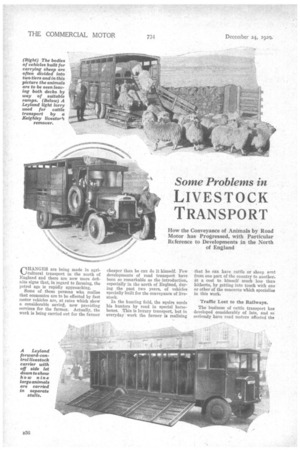Some Problems in
Page 54

Page 55

If you've noticed an error in this article please click here to report it so we can fix it.
LIVESTOCK TRANSPORT
How the Conveyance of Animals by Road Motor has Progressed, with Particular Reference to Developments in the North of England CHANGES are being made in agricultural transport in the north of England and there are now more definite signs that, in regard to farming, the petrol age is rapidly approaching.
Some of those persons who, realize that economies are to be effected by fast motor vehicles are, at rates which show a considerable saving, now providing services for the farmer. Actually, the work is being carried out for the farmer cheaper than he can do it himself. Few developments of road transport have been so remarkable as the introduction, especially in the north of England, during the past two years, of vehicles specially built for the conveyance of livestock.
In the hunting field, the squire sends his hunters by road in special horseboxes. This is luxury transport, but in everyday work the farmer is realizing
that he can have cattle or sheep sent from one part of the country to another. at a cost to himself much less than hitherto, by getting into touch with one or other of the concerns which specialize in this work.
Traffic Lost to the Railways.
The business of cattle transport has developed considerably of late, and so seriously have road motors affected the railways that the companies are now looking into the matter and are, in fact, themselves using road vehicles for this work. There are also indications that the railway companies intend to give greater attention to this phase of transport. In cases in which the railways are not actually operating livestock vehicles, they are showing themselves alive to the situation by undertaking the duty of conveying animals from auction marts and similar places to the railway goods yards, without the assistance of the owners of the beasts. This is much more than they could, at one time, be persuaded to do, and is an inditatiou of the effect of competition.
At the present time much experimental work is being affected in regard to bodywork for livestock vehicles. In many instances the machines that are used by cattle removers are second-hand and have been adapted to the work. There is a division of opinion amongst users as to whether vehicles should be loaded from the rear or from the sides, or from both rear and sides. All three methods have advantages. Vehicles have often to be driven into awkward places, and, where side loading or an
loading might, in one instance, he advantageous, the next time the vehicle is used it will probably be found that the other method will present certain benefits. Generally, cattle are carried facing across the vehicles, and side loading and unloading are an advantage if animals are to he removed individually.
Sheep are usually carried on two decks, and this means ' that adequate ventilation must be provided for the occupants of both floors. For the loading of one or two sheep it is often an advantage to have a small door on one side of the lorry and through this door a sheep can be lifted. The carrying of the flooring for the upper deck is a problem, but ',this is frequently surmounted by using the boards which constitute the stalls for the cattle.
Cleansing and Disinfecting Cattlecarrying Vehicles.
The representatives of the Ministry of Agriculture and the police ensure that the regulations with regard to the thorough cleansing and disinfection of a vehicle after it has been used for one load, end before it is used for the next, are observed, and at all auction marts
arrangements are made for this to be done. Some of the arrangements are far from satisfactory, however, and involve much waste of time. At some places special charges are made for the use of water for this service. Many of •the loads carried are extremely valuable and it devolves upon the carrier to insure the animals while in transit. This insurance is effected by special policies.
Long journeys are often undertaken by road, and from the West Riding to the East Riding there are, at certain seasons of the year, big migrations of sheep, the hill sheep being sent down for the winter to the lower levels in the East Riding and returned for the lambing season. The Yorkshire farms_are also scoured for stock for the Lancashire markets and slaughter houses, and this means a cross-country journey, often across roads which are very narrow, but the drivers are familiar with the work and soon become accustomed to the handling of animals.
Mishaps with livestock while in the vehicles are extremely rare and the beasts are always in much better condition after a journey by road than after travelling in a train.




































































































